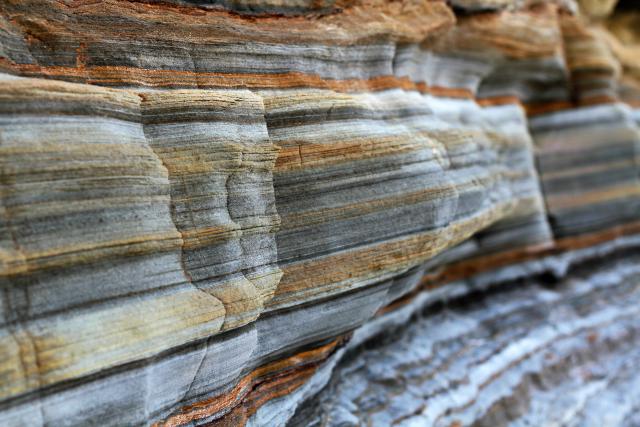
(Source: Barry Tuck, Shutterstock.com)
It’s hard being a rock. Depending on your physical structure and where you reside, you are either a good rock or a bad rock. For oil and gas, sedimentary rocks in general are good, and those trapped and soaked with oil are better. Understanding rock properties makes it possible to determine how much fluid (oil, water or both) the rock holds.
These are properties that can take up to a year or more to measure in a laboratory setting, Joanne Fredrich, upstream technology senior adviser at BP, explained for reporters at an Offshore Technology Conference (OTC) press event in early May.
One way of getting these rocks from the reservoir to the laboratory is collecting sidewall cores during the drilling of an exploratory or appraisal well. For BP, these thumb-sized cores hold the reservoir’s physical and chemical secrets, and decoding them is job one for experts like Fredrich. Rather than waiting a year or more for the rest of the reservoir story, the company developed its digital rocks program 10 years ago to speed up the process.
Members of the company’s multidisciplinary digital rocks team—with experts in 3-D imaging, fl uid mechanics, numerical modeling, computational physics and more—use micro-CT scanners to image the sidewall core samples to create a 3-D digital model of the rock. The company is able to measure rock properties in a matter of days to a couple of weeks, according to Fredrich.
The digital rocks program is now in line for a key upgrade thanks to the recent inking of a multiyear software licensing agreement between BP and Exa Corp. The upgrade—known as multiphase fl uid fl ow simulation technology—makes it possible to simulate the flow of oil and water in the digital images of BP’s reservoir rocks.
According to Fredrich, measuring how oil fl ows relative to water when both are present in the reservoir could take up to 18 months in the laboratory. With the upgrade to digital rocks, this measurement time has been reduced.
The agreement, announced at OTC, is the end result of an intensive three-year technology development collaboration between the two companies.
“We worked with Exa to take its existing complex fluids simulation technology—which it developed for use in the automotive and aeronautical industries—and from there, we built in the capability to model these two-phase fl ows in the digital rocks,” Fredrich said.
This new capability makes it possible for engineering teams to make more informed decisions on wells, production facilities and EOR.
“After years of cooperative research and development, this breakthrough represents an important step forward for BP and for our industry,” said Ahmed Hashmi, BP’s head of upstream technology. “It underscores BP’s continued leadership in digital technologies and their increasingly important role in helping us to develop energy resources safely, effectively and economically.”
On another note, as I step into my new role covering drilling technologies, I look forward to hearing your ideas and insights on the industry. Please let me know what you’d like to see covered here and I will do my best to make it happen. Give me a call at 713-260-6470 or drop me a note at jpresley@hartenergy.com.
Recommended Reading
Huddleston: Haynesville E&P Aethon Ready for LNG, AI and Even an IPO
2025-01-22 - Gordon Huddleston, president and partner of Aethon Energy, talks about well costs in the western Haynesville, prepping for LNG and AI power demand and the company’s readiness for an IPO— if the conditions are right.
Judgment Call: Ranking the Haynesville Shale’s Top E&P Producers
2025-03-03 - Companies such as Comstock Resources and Expand Energy topped rankings, based on the greatest productivity per lateral foot and other metrics— and depending on who did the scoring.
Tracking Frac Equipment Conditions to Prevent Failures
2024-12-23 - A novel direct drive system and remote pump monitoring capability boosts efficiencies from inside and out.
Formentera Joins EOG in Wildcatting South Texas’ Oily Pearsall Pay
2025-01-22 - Known in the past as a “heartbreak shale,” Formentera Partners is counting on bigger completions and longer laterals to crack the Pearsall code, Managing Partner Bryan Sheffield said. EOG Resources is also exploring the shale.
E&P Highlights: Jan. 21, 2025
2025-01-21 - Here’s a roundup of the latest E&P headlines, with Flowserve getting a contract from ADNOC and a couple of offshore oil and gas discoveries.
Comments
Add new comment
This conversation is moderated according to Hart Energy community rules. Please read the rules before joining the discussion. If you’re experiencing any technical problems, please contact our customer care team.





